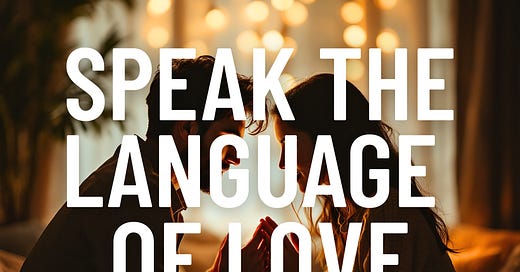Speak the Language of Love
Clear Communication is about learning to express yourself in a way that your partner can truly understand—and creating a space where they feel safe to do the same.
Communication is the Heartbeat of Love
Hey there, my friend
Let’s be honest—relationships are as beautiful as they are challenging.
And if there’s one thing that can make or break a partnership, it’s communication.
Think back to a time when you felt misunderstood by your partner.
Maybe you were trying to express how you felt, but the words didn’t come out right.
Or perhaps your partner said something that left you feeling hurt, even though they claimed they “didn’t mean it that way.”
Moments like these can leave us frustrated, disconnected, and unsure of how to bridge the gap between what we feel and what we say.
But here’s the good news: just like love itself, communication is something you can nurture, grow, and master.
Clear communication doesn’t mean you’ll never argue or make mistakes. It means you’ll argue better, rebuild faster, and deepen your connection through every conversation.
It’s about learning to express yourself in a way that your partner can truly understand—and creating a space where they feel safe to do the same.
In this article, we’re going to dive deep into the art of clear communication in romantic relationships. We’ll explore why misunderstandings happen, how to express yourself with clarity and empathy, and how to truly listen to your partner in a way that strengthens your bond.
By the end, I hope you’ll feel more equipped and inspired to connect with your partner on a deeper level.
Let’s get started.
The Foundation of Clear Communication
At its core, communication in a romantic relationship isn’t just about talking; it’s about connection. It’s about making your partner feel seen, heard, and valued.
But what does that actually look like in practice? Let’s break it down.
Clarity: Saying What You Mean
Have you ever found yourself saying, “You should know what I mean!” to your partner? It’s a common trap. We often expect our loved ones to read our minds because we assume they “know us so well.”
But the truth is, even the most attentive partner can’t read your thoughts.
Clarity means expressing yourself in a way that leaves no room for guesswork.
Instead of saying, “You never help out around the house,” try being specific: “I feel overwhelmed with the chores lately, and it would mean so much if you could take care of the dishes tonight.”
Notice the difference? The first statement is vague and accusatory, while the second is specific and constructive.
Empathy: Seeing Through Their Eyes
Empathy is the ability to put yourself in your partner’s shoes. It’s not about agreeing with everything they say or feel, but about understanding where they’re coming from.
Imagine your partner comes home from work and snaps at you for no apparent reason. Instead of reacting defensively, pause and ask yourself, What might they be feeling right now? Are they stressed, tired, or overwhelmed? A simple empathetic response like, “You seem frustrated—do you want to talk about what’s bothering you?” can completely shift the tone of the conversation.
Empathy turns conflict into connection. It’s the glue that holds meaningful communication together.
Why Miscommunication Happens in Love
Even couples who love each other deeply can struggle with miscommunication. Why? Because it’s not just about what you say—it’s about how it’s received.
1. Assumptions Create Distance
One of the most common communication barriers is assuming your partner should “just know” what you need. Maybe you’ve thought, If they really loved me, they’d figure it out.
But here’s the thing: love doesn’t come with a user manual. Your partner might not see things the way you do, and that’s okay—it’s why communication is so important.
Instead of waiting for your partner to guess, try being direct. For example, instead of hoping they’ll notice you’re upset, say, “I’ve been feeling a little off today. Can we talk about it?” This removes the guesswork and invites them into your experience.
2. Emotions Cloud the Message
Picture this: You’ve had a rough day, and your partner makes an innocent comment that hits a nerve. Before you know it, you’re snapping at them for something they didn’t even realize was an issue.
It happens to the best of us. When emotions are running high, it’s easy to let frustration, anger, or sadness take over.
The key is to recognize when emotions are coloring your communication.
If you feel yourself about to explode, take a deep breath and say, “I need a moment to calm down before we talk.” This simple pause can prevent hurtful words and keep the conversation productive.
How to Express Yourself Clearly and Kindly
Now that we’ve explored the barriers to communication, let’s shift to solutions. Here’s how you can express yourself in a way that fosters understanding and connection.
1. Use “I” Statements
One of the quickest ways to derail a conversation is to start with “You.”
For example, “You never listen to me!” immediately puts your partner on the defensive. Instead, try framing your feelings with “I” statements:
“I feel unheard when I’m interrupted.”
“I feel hurt when plans change without notice.”
“I” statements focus on your experience rather than accusing your partner, making it easier for them to understand and respond.
2. Be Specific About Your Needs
Vagueness leads to frustration. If you want your partner to support you, be clear about how.
Instead of saying, “I need you to be more attentive,” try, “It would mean a lot if we could spend 30 minutes together tonight without distractions.”
Specificity gives your partner a roadmap to meet your needs.
3. Validate Their Feelings
Validation doesn’t mean you have to agree with everything your partner says. It simply means acknowledging their emotions.
For example:
“I can see why you’d feel that way.”
“It makes sense that you’re upset.”
Validation shows your partner that their feelings matter, which builds trust and emotional safety.
The Art of Listening
Communication isn’t just about speaking—it’s about listening. And not just listening to respond, but listening to understand.
1. Practice Active Listening
Active listening means giving your partner your full attention.
Put down your phone, make eye contact, and show that you’re engaged. When they finish speaking, summarize what you’ve heard to ensure you understand.
For example:
“So, you’re feeling overwhelmed by work, and you’d like more help at home. Is that right?”
This simple act of paraphrasing shows your partner that you’re truly listening, not just waiting for your turn to talk.
2. Ask Open-Ended Questions
Open-ended questions invite deeper conversations.
Instead of asking, “Did you have a good day?” try, “What was the best part of your day?”
The more space you give your partner to share, the closer you’ll feel.
Navigating Tough Conversations
No relationship is without conflict. The key is learning how to handle tough conversations with grace and respect.
1. Choose the Right Time
Timing matters.
Don’t bring up sensitive topics when your partner is stressed or distracted. Instead, choose a calm moment when you can both focus on the conversation.
2. Stay Solution-Oriented
Instead of focusing on who’s “right” or “wrong,” shift the conversation toward finding solutions.
For example:
“How can we make sure this doesn’t happen again?”
By working together as a team, conflicts become growth opportunities.
Conclusion: Communication is the Bridge to Love
My friend,
Relationships aren’t about being perfect—they’re about being present.
Communication isn’t something you master overnight, but every small effort you make brings you closer to the love and connection you desire.
Start with something small today. Maybe it’s using an “I” statement instead of “You,”
Or asking your partner an open-ended question about their day.
These little shifts can lead to profound changes in how you connect and communicate.
Remember, love doesn’t thrive in silence—it thrives in understanding. And understanding begins with clear, kind, and empathetic communication.
You’ve got this.
Because you deserve nothing less!
— Your Advocate for Growth
Join the Movement
You’re not here by accident. You’re someone who knows there’s more to life than just going through the motions. You’re someone who’s ready to dig deeper, to grow, and to discover what’s truly possible for you.
This newsletter exists for the seekers, the deep thinkers, the ones who know there's more to understanding ourselves and our world.
This is more than just a newsletter—it’s a mission. A mission to help people wake up, take control, and build a life of true power and clarity. If you’re ready to step into your full potential, you’re in the right place.
Together, we create a community that values knowledge, and compassion, in the pursuit of a better world for all.
Subscribe to Unshaken Reality and become part of the movement that will uplift and inspire the rest of your life, one piece of information at a time.





